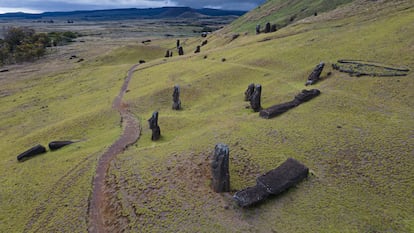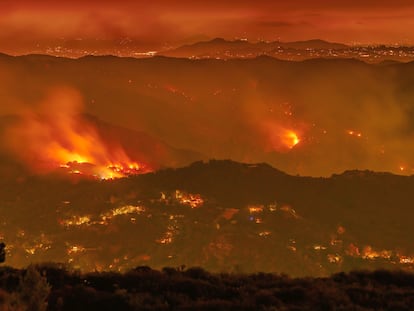A snapshot of the moai burned by a fire on Easter Island: ‘The damage is much greater than we imagined’
Of the 222 stone statues damaged last October, 22 show ‘serious alterations,’ according to the UNESCO-led investigation


According to a recently released UNESCO-led investigation, last October over 350 archaeological pieces were damaged by a ferocious fire that affected the quarry of the Rano Raraku volcanic crater on Easter Island. Of the heritage harmed by the flames in the quarry where the ancient Rapa Nui made the majestic moai [monolithic carved human figures], 222 were statues; of those, 22 were “seriously altered” and must be treated in the short term, the document says. “The damage is much greater than we imagined,” the mayor of Easter Island, Pedro Edmunds, said by telephone.
The fire occurred in a particularly sensitive heritage area on the triangular island located in the middle of the Pacific Ocean; the site forms part of the Chilean region of Valparaiso, which is 3,600 kilometers (about 2237 miles) away. In the Rano Raraku quarry, several moai are unfinished and half buried, like the Te Tokanga, which is 22 meters (about 72 feet) long and weighs some 200 tons. That allowed half of the mysterious statues to be protected from the fire that struck the island, which UNESCO declared a World Heritage Site in 1986.
The UNESCO archaeologists, members of the Mau Henua indigenous community and governmental and civil society organizations that prepared the report concluded that, beyond the flames, climatic and water-related factors are the most recurrent and damaging to the moai. Biological erosion accelerates the process of deteriorating the statues’ outer layer, impacting between 5 and 10 centimeters (about 2 to 4 inches) of the surface of the unique rock from which the volcano is formed, lapilli tuff. “Time, rain and wind are eroding them. If we don’t do something, they will disappear in 100 years,” warns Edmunds.

Claudia Uribe, the UNESCO representative in Chile, explains that water repellency and stone adhesion techniques can be applied to conserve the heritage pieces. A few years ago, this sophisticated methodology was used to great success; it was also employed over two decades ago in the Ahu Tongariki ceremonial center, where 15 moai stand. In previous fires that affected some moai, Japanese and Chilean scientists from the National Monuments Council applied chemical solutions to the stone to provide a layer of protection.
Daniela Meza, the Ma’u Henua indigenous community’s archaeologist and curator, explains that it is a very slow and costly process. Each moai requires two to three months of work and importing a series of materials from foreign laboratories. “The materials are not so expensive, but the customs costs are,” she says. Meza says that, before the fire, she had drawn up an emergency list of the statues in the worst condition. “There are about 15. They have not burned but [their state is] more serious. They are next to the sea and practically falling apart. Once we have the permit from Monuments, we are going to restore their physical strength so that they can continue to stand,” says the archaeologist. Meza is working with a team to design a less administratively cumbersome methodology to protect the moai.
Mayor Edmunds says he does not have the figures for how much it will cost to apply the protection technique to the 22 most fire-damaged moai. Uribe clarifies that UNESCO will not offer the resources to finance such restoration and repair treatments: “Today’s challenge is to raise funds to initiate a conservation plan.” Before that, experts will draw up a risk management plan to strengthen local response capacities in the event of fire or other emergencies. The entire UNESCO fire project has a budget of $97,000 for one year, financed by the agency’s Heritage Emergency Fund (HEF), which seeks to preserve and conserve such sites.
The island, which derives its income from tourism, was closed for two and a half years because of the Covid-19 pandemic. Although the mayor will go to the UN next week to discuss how they managed to have only five cases of Covid-19 and not a single death, the Rapa Nui economy suffered greatly. It is still crippled. The island is receiving only three flights a week (750 passengers), compared to the 14 flights (8,000 passengers) that were arriving before the lockdown.
Last Thursday, Chile’s National Cultural Heritage Service (SERPAT) signed a $620,000 agreement with the municipality of Easter Island and the Ma’u Henua indigenous community, which administers the Rapa Nui National Park. The funds will be used to strengthen the management of the historic site and revive the economy. Each islander notices the economic effects on their lives. For example, Daniela Meza can no longer raise funds from the community when she needs to protect a moai.
Sign up for our weekly newsletter to get more English-language news coverage from EL PAÍS USA Edition









































